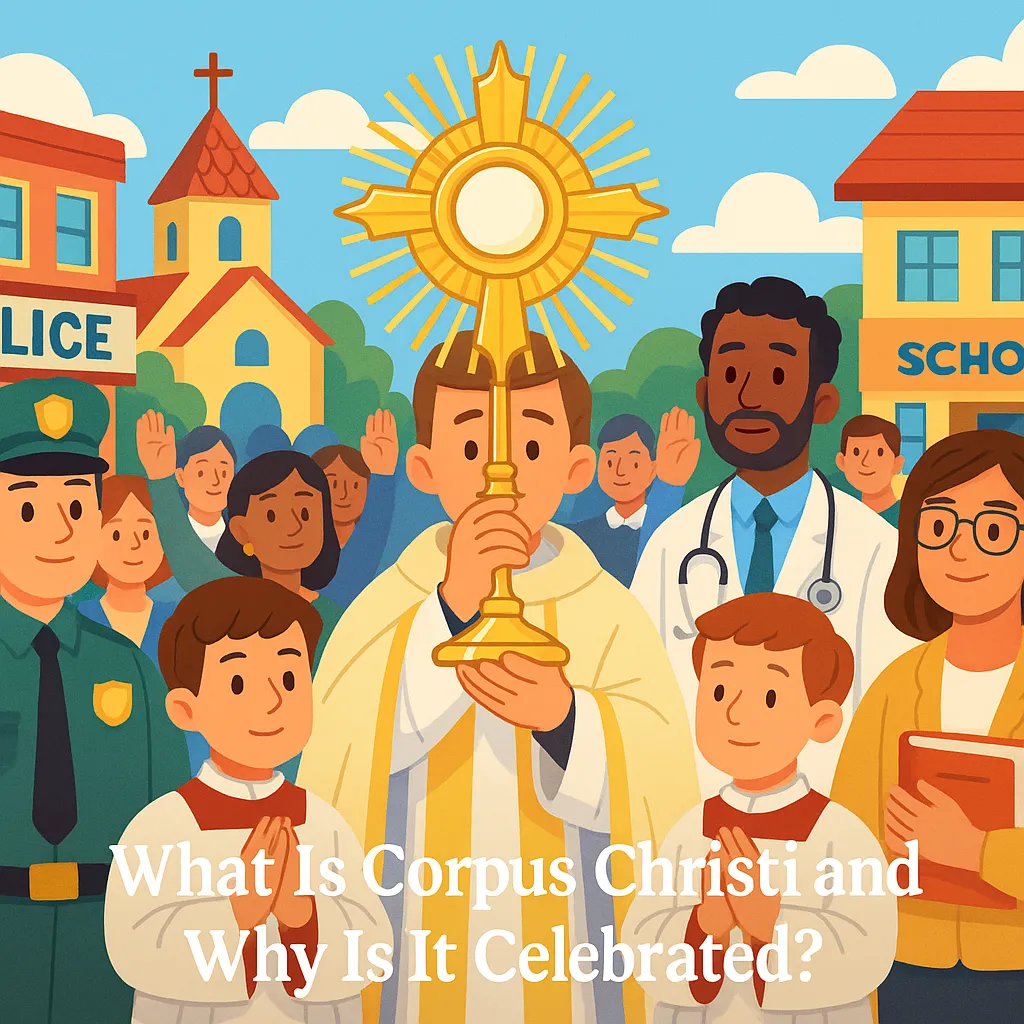Guides, Corpus Christi Day, Holidays
What Is Corpus Christi and Why Is It Celebrated?
Each year, 60 days after Easter Sunday, Catholics around the world gather to honor one of the most sacred and profound mysteries of the Christian faith — the Solemnity of Corpus Christi, also known as the Feast of the Body and Blood of Christ.
Marked by elaborate processions, reverent Masses, and vibrant traditions that span continents and centuries, Corpus Christi is more than a religious observance — it’s a powerful, public proclamation of faith in the real presence of Christ in the Eucharist.
But what exactly is Corpus Christi? Where did it come from? And why does it continue to hold such deep significance in the hearts of believers today?
Let’s explore the theology, history, and global celebration of this remarkable Catholic feast.
What Does “Corpus Christi” Mean?
The phrase Corpus Christi comes from Latin, meaning “Body of Christ.” In the context of Catholic theology, it refers specifically to the belief that Jesus Christ is truly present — body, blood, soul, and divinity — in the consecrated elements of the Eucharist (Holy Communion).
This feast celebrates the institution of the Holy Eucharist, which occurred at the Last Supper, and honors the ongoing mystery of Christ’s real presence under the appearance of bread and wine.
When Is Corpus Christi Celebrated?
Corpus Christi is observed on the Thursday after Trinity Sunday, which is the Sunday following Pentecost. This places the feast 60 days after Easter, typically in late May or June.
However, in many countries (such as the United States and Canada), the feast is transferred to the following Sunday to allow greater participation by the faithful.
📅 In 2025, Corpus Christi falls on Thursday, June 19 (or Sunday, June 22, where transferred).
Origins of the Feast
A Vision that Became a Global Feast
While the Eucharist has been celebrated since the earliest days of Christianity, the formal feast of Corpus Christi was established in the 13th century, thanks to the efforts of a devout Belgian nun named St. Juliana of Liège.
St. Juliana experienced visions in which Christ asked for a special feast dedicated to His Body and Blood — to reaffirm the Church’s belief in His real presence in the Eucharist and to combat growing heresies of the time.
Her visions were taken seriously by local clergy, including the future Pope Urban IV, who officially instituted the Feast of Corpus Christi for the universal Church in 1264 with the papal bull Transiturus de hoc mundo.
The Theology Behind Corpus Christi
At its core, Corpus Christi is a celebration of the Eucharist, which is not simply symbolic in Catholic belief, but the actual presence of Christ.
“This is My Body… This is My Blood.” – Matthew 26:26-28
The feast is meant to:
- Reaffirm faith in the mystery of the real presence
- Deepen reverence for the sacrament
- Bring the Eucharist into public witness through processions and adoration
It’s a reminder that Christ is not distant or historical — but alive and present, here and now, in the bread broken and shared.
How Corpus Christi Is Celebrated Around the World
Celebrations vary across cultures, but several key elements remain common:
1. Solemn Mass
Parishes hold special liturgies with Eucharistic hymns and homilies focused on the meaning of the Eucharist.
2. Eucharistic Procession
Perhaps the most visually striking element: the consecrated Host, placed in a monstrance, is carried through the streets under a canopy. The faithful follow in prayer and song, creating a public act of adoration.
3. Altars and Decorations
Along the procession route, communities build temporary altars adorned with flowers, banners, and symbolic imagery. Streets may be decorated with petals, sand carpets, or Eucharistic art.
4. Music and Tradition
In places like Spain, Peru, Poland, and the Philippines, traditional music, dancing, and local customs enrich the celebration.
Symbolism and Significance
Corpus Christi is one of the few feasts that extends the mystery of the Mass into the public square. It invites Catholics to:
- Proclaim their faith openly
- Reverence Christ in the Eucharist beyond the walls of the church
- Bear witness to the transformative power of the sacrament
In a world of increasing secularism, the feast serves as a countercultural statement: that the sacred still dwells among us.
Corpus Christi Beyond the Feast Day
While the celebration lasts a day, its impact should ripple through the entire year. Corpus Christi reminds us to:
- Approach the Eucharist with deeper awe and gratitude
- Make time for Eucharistic Adoration
- Reflect on the meaning of Christ’s sacrifice and presence
- Let the Body of Christ form a community of love and service
Final Thought
Corpus Christi is not just a feast — it is a declaration. A reminder. A procession of hearts and feet toward the God who chose to remain with us in the simplest form: bread.
This June, whether you attend a grand procession or simply kneel in quiet adoration, remember:
The Body of Christ is not only on the altar —
It walks with us, feeds us, and calls us to become what we receive.

